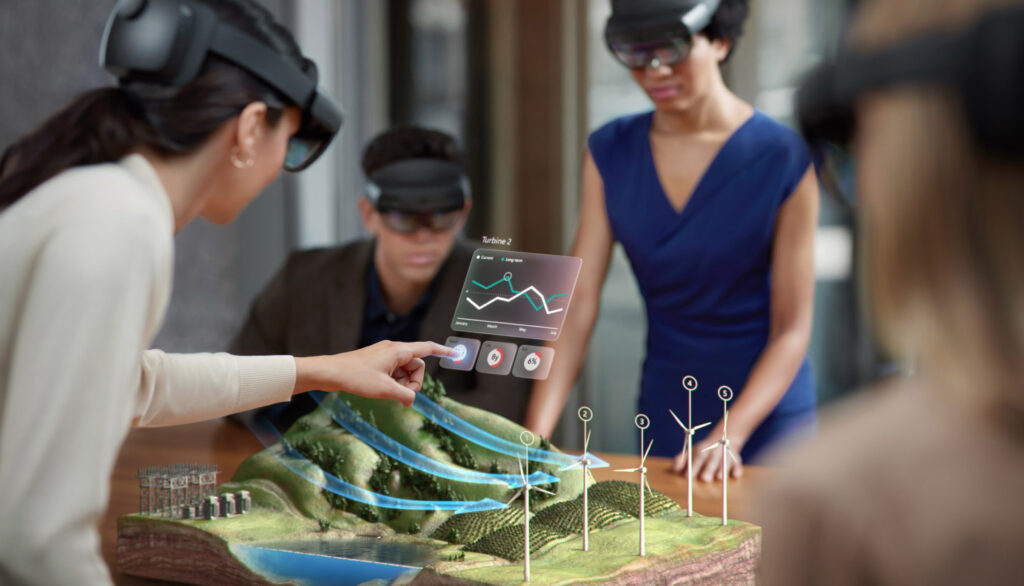
As technology continues to advance, we have seen a rise in new forms of immersive technology such as AR and VR. These two technologies have been the buzz in the tech industry in recent years, and they have been utilized in various applications such as the gaming, education, and marketing industry. However, many people still confuse AR with VR, and it is important to understand the differences between them. In this article, we will explore AR and VR, the differences between them, their advantages and applications, and how they work together.
What is AR?

AR stands for Augmented Reality. It is a technology that superimposes digital information, images, or objects onto the real world. AR adds digital content to our real-world surroundings, creating a new environment that enhances our perception of reality. AR is typically experienced through a device such as a smartphone, tablet, or smart glasses. With AR, the real world serves as a foundation, while digital content is added to enhance the user experience.
AR can be used in various applications such as gaming, education, and marketing. AR allows players to interact with virtual objects in the real world, creating a more immersive gaming experience. In education, AR can be used to supplement traditional teaching methods, making learning more interactive and engaging. In marketing, AR can be used to create interactive product demonstrations, allowing customers to visualize products in real-world scenarios.
What is VR?

VR stands for Virtual Reality. It is a technology that creates a completely digital environment that is designed to simulate reality. VR utilizes a headset, which completely blocks out the real world and replaces it with a digital environment. The headset tracks the user’s movements and adjusts the digital environment accordingly, creating a fully immersive experience.
VR can also be used in various applications such as gaming, education, and marketing. VR allows players to completely immerse themselves in a virtual world, creating a more immersive gaming experience. In education, VR can be used to create simulations that allow students to experience real-world scenarios. In marketing, VR can be used to create interactive product demonstrations, allowing customers to visualize products in a virtual environment.
Differences between AR and VR using a table
AR and VR have some similarities, but they are fundamentally different technologies. Here is a table that highlights the differences between AR and VR:
| Content | Augmented Reality (AR) | Virtual Reality (VR) |
|---|---|---|
| Definition | Adds digital content to the real world | Creates a completely digital environment that simulates reality |
| Hardware | Devices such as smartphones, tablets, or smart glasses | Headsets |
| Real-world environment | Serves as a foundation for digital content | Completely blocked out |
| Digital environment | Adds digital content to the real world | Completely replaces the real world |
| User experience | Enhances the real world with digital content | Immerses the user in a digital environment |
| Movement tracking | Uses camera-based tracking | Uses headset-based tracking |
| Applications | Gaming, education, marketing, healthcare, etc. | Gaming, education, marketing, healthcare, etc. |
Advantages and Applications
AR and VR have numerous advantages and applications. Here are some of them:
Advantages of AR
- Enhances the user experience: AR adds digital content to the real world, creating a new environment that enhances our perception of reality. This creates a more immersive experience, which can be used to enhance gaming, education, and marketing.
- Increased engagement: AR provides a more interactive and engaging experience. This can be used in education and marketing to create more engaging content that captures the user’s attention.
- Real-world applications: AR can be used in various industries such as healthcare, engineering, and construction, where it can be used to create simulations and visualizations that enhance real-world scenarios.
- Accessible hardware: AR can be experienced through devices such as smartphones, tablets, or smart glasses, which are more accessible and affordable than VR headsets.
Applications of AR
- Gaming: AR can be used to create immersive gaming experiences by adding digital content to the real world. Games such as Pokemon Go and Ingress are popular examples of AR games.
- Education: AR can be used to supplement traditional teaching methods, making learning more interactive and engaging. For example, AR can be used to create interactive textbooks, allowing students to interact with 3D models of concepts they are learning.
- Marketing: AR can be used to create interactive product demonstrations, allowing customers to visualize products in real-world scenarios. For example, IKEA has an AR app that allows customers to see how furniture will look in their home before making a purchase.
- Healthcare: AR can be used to create simulations that allow medical professionals to practice surgeries or diagnose conditions in a virtual environment.
Advantages of VR
- Complete immersion: VR completely replaces the real world with a digital environment, creating a fully immersive experience. This can be used to create more engaging and realistic simulations in gaming, education, and healthcare.
- Better movement tracking: VR headsets use headset-based tracking, which is more accurate than camera-based tracking used in AR. This allows for more realistic movement in virtual environments.
- Unique experiences: VR allows users to experience things that are not possible in the real world, such as visiting space or underwater environments.
- Increased safety: VR can be used in industries such as healthcare and aviation to create simulations that allow professionals to practice dangerous scenarios in a safe environment.
Applications of VR
- Gaming: VR can be used to create immersive gaming experiences that completely transport players to a virtual world. Games such as Beat Saber and Half-Life: Alyx are popular examples of VR games.
- Education: VR can be used to create simulations that allow students to experience real-world scenarios. For example, VR can be used to simulate a chemistry lab or a historic location.
- Marketing: VR can be used to create interactive product demonstrations, allowing customers to visualize products in a virtual environment. For example, car manufacturers can use VR to create virtual showrooms.
- Healthcare: VR can be used to create simulations that allow medical professionals to practice surgeries or diagnose conditions in a virtual environment.
How AR and VR Work Together
Although AR and VR are often seen as separate technologies, they are used together to create a more immersive experience. This combination is known as Mixed Reality (MR). MR allows digital content to be seamlessly integrated into the real world, which creates an environment that blurs the line between the real and digital world.
MR can be used in various applications such as gaming, education, and marketing.
For example, in gaming, MR can be used to create a more immersive experience by adding digital content to the real world, while still allowing players to interact with their surroundings. In the education sector, MR is used to create interactive textbooks that allow students to interact with 3D models of concepts they are learning. In marketing, MR is used to create interactive product demonstrations that allow customers to visualize products in real-world scenarios.
Conclusion
AR and VR are both immersive technologies that have revolutionized the way we interact with digital content. While they have similarities, they are fundamentally different technologies with their own unique advantages and applications. AR enhances the real world with digital content, while VR completely replaces the real world with a digital environment. Both technologies have numerous applications in gaming, education, and marketing, and are used together to create a more immersive experience through Mixed Reality. As technology continues to advance, we can expect to see even more innovative applications for AR, VR, and MR in various industries, such as healthcare, entertainment, and education. The future of AR, VR, and MR is exciting, and we can expect to see even more immersive and realistic experiences in the years to come.
In conclusion, the choice between AR and VR largely depends on the specific use case and the desired level of immersion. By understanding the differences between AR and VR and their various applications, businesses can make informed decisions about which technology to use to achieve their desired outcomes.




